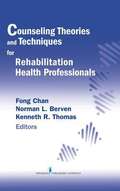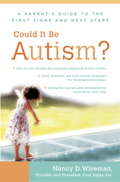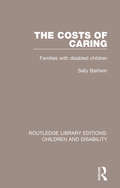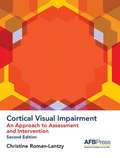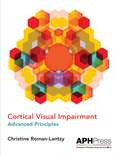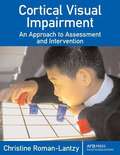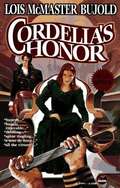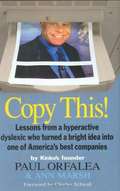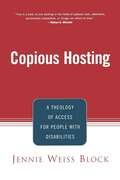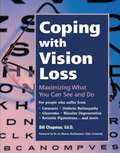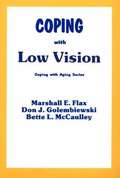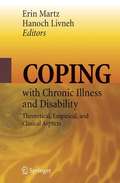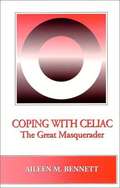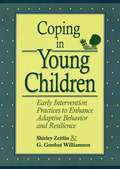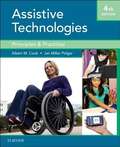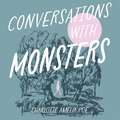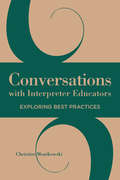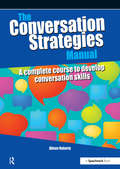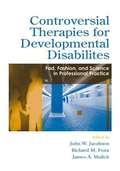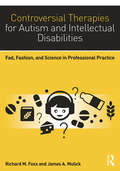- Table View
- List View
Counseling Theories and Techniques for Rehabilitation Health Professionals
by Fong Chan Norman L. Berven Kenneth R. ThomasForty-three American academics and practitioners discuss the dominant theories and techniques of counseling and psychotherapy from a rehabilitation perspective. Coverage includes reviews of ten psychodynamic, humanistic, and cognitive and behavioral approaches to counseling; basic techniques; considerations for specific types of disabilities; and professional issues. Each chapter includes a case example. Annotation ©2004 Book News, Inc., Portland, OR (booknews.com)
Counseling Theories and Techniques for Rehabilitation Health Professionals
by Kenneth R. Thomas Norman L. Berven Fong ChanForty-three American academics and practitioners discuss the dominant theories and techniques of counseling and psychotherapy from a rehabilitation perspective. Coverage includes reviews of ten psychodynamic, humanistic, and cognitive and behavioral approaches to counseling; basic techniques; considerations for specific types of disabilities; and professional issues. Each chapter includes a case example.
Counseling the Emotionally Disturbed
by C. H. PattersonMental disturbance is frighteningly prevalent in our contemporary society. The number of those mentally disturbed who are or have been hospitalized should seriously concern every citizen in our country-especially all those working in such fields as medicine, education, psychology, social work, the courts, and the church. The devastating disease of mental disturbance strikes all ages and all levels of ability. To the untutored observer this malady seems to come without warning, although to the skilled in this field there are clearly identifiable danger signs that appear long before the popularly termed "nervous breakdown." Fortunately, there is widespread and telling evidence of the recognition of this situation in many directions. The necessity for effective counseling services for both young and old as a possible preventative against disastrous crack-ups is being considered and provided for by a wide array of institutions. Just as is true of any disease, mental disturbance demands treatment by personnel who are well grounded indeed in the nature and treatment of diseases of the mind. However, also just as is true of any disease, the highly skilled specialist must be bulwarked by many specialists in related activities. For example, in the same fashion as teachers, nurses, and medical technicians have been taught to become alerted to the possible presence of such common ailments as measles, whooping cough, scarlet fever, and so forth, it seems clear that a similarly wide range of workers must learn to recognize the presence or prospect of mental disturbance. And just as nurses and medical technicians do the bidding of and gather data for the surgeon, so must the specialist direct and be aided by the effort of others. To the knowledge of the writer, this volume is a pioneer effort. He is not familiar with any work outside the literature especially prepared for psychiatric training that deals with the counseling of the mentally disturbed. This treatise is a combination of theory, research, and common sense, which the author has gleaned from a wide sampling of the work of others and to which he, himself, has made no small contribution.
The Counseling Approach to Careers Guidance
by Lynda Ali Barbara Graham Susan LendrumFrom The Book Jacket The Counselling Approach to Careers Guidance offers a structured model which can be adapted to meet the specific needs of each client. Through detailed case material Lynda All and Barbara Graham show how to use counselling strategies with clients to enable them to change unhelpful patterns of thought and to move towards achievable goals. The book also explores materials available to careers counsellors and discusses important issues affecting their training and development within the public sector. This will be a useful handbook for experienced advisers and trainees in the careers service and a range of professional settings. Lynda All is Senior Careers Adviser, Edinburgh University. Barbara Graham is Director of the Careers Service, University of Strathclyde. Susan Lendrum is author of Gift of Tears and Case Material and Role Play in Counselling Training and a counsellor in private practice, Manchester. CAREERS GUIDANCE/COUNSELLING
Could It Be Autism?
by Nancy WisemanIf you have questions or concerns about your child's social, emotional, or behavioral development, you're not alone. The number of children affected by autism--an umbrella term for a wide spectrum of disorders that includes "classic" autism, Asperger's syndrome, and Rett syndrome--is growing every year. Most children are not diagnosed until they start school. But developmental problems can be recognized in infants as young as four months old. Early intervention can vastly improve a child's chances for a successful outcome and recovery. Could It Be Autism? provides vital information so you can recognize the red flags of developmental delays and begin treatment based on those first signs. Nancy Wiseman is the founder and president of First Signs, the organization dedicated to educating parents, clinicians, and physicians on the early identification of and intervention for developmental delays. She is also the mother of a child who was diagnosed with autism at the age of two, and she draws on her own experiences as well as the latest research to present real strategies. Emphasizing warning signs, she describes the most important milestones at each stage of a child's growth, including things parents and pediatricians often overlook. She also empowers parents to act on their instincts and initial concern, rather than to "wait and see," which is often encouraged. The book explains the steps parents can take to confirm or rule out a developmental delay or disorder. It details various diagnoses and show how sometimes multiple diagnoses may apply. But even more valuable is the information on how to design and implement the best intervention plan based on a child's unique developmental profile. Different treatments and therapies are outlined so parents can explore and understand what may work best for their child, based on his or her particular strengths and weaknesses.Ultimately, Could It Be Autism? is about giving parents hope--hope that they can know one way or the other where their child is developmentally and hope that they can give their child what he or she needs to have the best life possible.
The Costs of Caring: Families with Disabled Children (Routledge Library Editions: Children and Disability #4)
by Sally BaldwinFirst published in 1985, this book considers the financial consequences of parents and other relatives caring for severely disabled children at home. At the time of publication little reliable information was available on the costs incurred by ‘informal carers’, which this book set to rectify. The volume interweaves hard statistical material about money with the detailed personal responses of parents. It examines the claim that disablement in a child reduces parents’ earnings while simultaneously creating an extra expense. The author compares the incomes and expenditure patterns of more than 500 families with disabled children and 700 control families of the time showing that the financial effects of disablement in a child can be far-reaching and pervasive. This book discusses contemporary policy implications of these findings in a chapter dealing with the rational for compensating families with disabled children, and in the final chapter. Although the book was original published in 1985, it references issues that are still important today and, whilst its main concern is families with disabled children, it will also be useful to anyone caring for other kinds of dependent people, such as the elderly.
Cortical Visual Impairment: An Approach To Assessment And Intervention (Second Edition)
by Christine Roman-LantzyCortical Visual Impairment: An Approach to Assessment and Intervention provides educators, therapists, physicians, and parents of children with CVI with an understanding of the condition and a complete framework for assessment and intervention. The new and revised content in this second edition brings the book up-to-date with new research and insights into CVI, its development and progression, and the best approaches to assessment and intervention with children affected by this condition. As in the previous edition, assessment forms, including the CVI Range and CVI Progress Chart, provide a comprehensive method for evaluating the functional vision status of, and program planning for, children with CVI.
Cortical Visual Impairment: Advanced Principles
by Christine Roman-LantzyCortical Visual Impairment: Advanced Principles, the highly anticipated companion book to Cortical Visual Impairment: An Approach to Assessment and Intervention, makes new strides in building knowledge about CVI. The book, a collaboration among experts in several disciplines, dives deeper into topics that are extensions of the original concepts. CVI: Advanced Principles offers an in-depth examination of the needs of students and individuals with CVI in areas such as literacy, social skills, and O&M, while also addressing the demands of students with CVI and other disabilities, such as complex communication needs and hearing loss. The authors consider students with CVI in the context of their entire day to see how the tasks they perform, the interactions they have, and the environments they encounter can be evaluated and adapted to help them build their visual skills and experience success.
Cortical Visual Impairment: An Approach to Assessment and Intervention
by Christine Roman-LantzyThe definition, nature, and treatment of CVI are the focus of great concern and widespread debate, and this complex condition poses challenges to professionals and families seeking to support the growth and development of visually impaired children. This one-of-a-kind resource provides readers with both a conceptual framework with which to understand working with CVI and concrete strategies to apply directly in their work.
Cordelia's Honor (Cordelia Naismith Omnibus)
by Lois Mcmaster Bujold2 stories: Shards of Honor, and Barrayar, forming a continuous story of the life of Cordelia Vorkosigan nee Naismith, Miles' mother. Winner of the Hugo Award.
Copy This!: Lessons From A Hyperactive Dyslexic Who Turned A Bright Idea Into One Of America's Best Companies
by Paul Orfalea Ann MarshBill Moyers said this about Paul Orfalea after reading Copy This!: "If I could live my life over again, I would sit at his feet and listen to everything he has to say. " And David Brancaccio, host of NOW on PBS, wrote: "As the host for a decade of a daily business program, I had to read what seemed like every business book published in the English language. It is, therefore, with authority that I can say Paul Orfalea's book is wonderful, heartbreaking, and profoundly useful. " <P><P> Copy This!, Paul Orfale's memoir of turning lemons into lemonade, is wise, personal, funny, unflinchingly honest, and filled with wisdom, business lessons, and his inspired Orfalea Aphorisms. It's the story of how a struggling kid who could barely read, write, or sit still managed to grow a 100-square-foot copy shop named Kinko's into a $1. 5 billion empire that Fortune named one of the best places in America to work. And it's the story of an individual who saw his learning disabilities-ADHD and dyslexia-as learning opportunities, which molded the homegrown, compassionate culture that allowed Kinko's to thrive, and guided the behavior of a CEO who had no choice but to think different. A terrifically entertaining read from a born storyteller, but with the hardcore guts of true business acumen, Copy This! will blow fresh air into the thinking of any manager, entrepreneur, executive, or business owner.
Copious hosting: a theology of access for people with disabilities
by Jennie Weiss BlockDiscusses working with people with developmental disabilities in the Roman Catholic church
Copious Hosting: A Theology of Access For People With Disabilities
by Jennie Weiss BlockIt is estimated that there are 43 million Americans with one or more physical or mental disabilities. Over the past several decades, the disability movement has grown in strength and sophistication, attaining maturity with the Americans with Disabilities Act of 1990. This landmark civil rights legislation ushered in a new era for people with disabilities. <p><p>Many religious people, however well-meaning, are unfamiliar with the language and philosophy of the disability movement. They unintentionally give offense by language and actions that reflect a by-gone era. <p><p>This book aims to do two things: to acquaint church and synagogue leaders with the history and philosophy of the disability movement and to provide resources from scripture and theology for thinking and preaching about disability in a new way.
Coping with Vision Loss: Maximizing What You Can See and Do
by Bill ChapmanLegally blind for 30 years, Chapman explains fundamental facts about eyes and vision, including the causes and varieties of blindness. He also examines the new skills the partially sighted person must learn. Specific approaches and devices are covered in depth, including "eccentric viewing" and driving with telescopic glasses.
Coping with Low Vision (Coping with Aging)
by Bette L. Mccaulley Don J. Golembiewski Marshall E. Flax"The books in the Coping with Aging Series are written for men and women coping with the challenges of aging, and for their families and other caregivers. The authors are all experienced practitioners: doctors, nurses, social workers, psychologists, pharmacists, nutritionists, audiologists, physical and occupational therapists, and speech-language pathologists."
Coping with Endometriosis
by Glenda Motta Robert H. PhillipsSound, Compassionate Advice for Alleviating the Physical and Emotional Symptoms of This Frequently Misunderstood Illness
Coping With Chronic Illness And Disability: Theoretical, Empirical, And Clinical Aspects
by Hanoch Livneh Erin MartzThis book synthesizes the expanding literature on coping styles and strategies by analyzing how individuals with CID face challenges, find and use their strengths, and alter their environment to fit their life-changing realities. The book includes up-to-date information on coping with high-profile conditions, such as cancer, heart disease, diabetes, arthritis, spinal cord injuries, and traumatic brain injury, in-depth coverage of HIV/AIDS, chronic pain, and severe mental illness, and more.
Coping with Celiac: the Great Masquerader
by Aileen M. BennettThis is a book about sharing: shared stories, recipes, information about books that have been of help and general advice. This is a book for those who have Celiac Sprue, a disorder that makes the gluten that is in many foods a poison. This is easy to read and has lots of good resources.
Coping in Young Children: Early Intervention Practices to Enhance Adaptive Behavior and Resilience
by Shirley Zeitlin G. Gordon WilliamsonA guide for early intervention professionals describing the ways to assist children with disabilities to integrate and apply their developmental skills for greater flexibility and independent problem solving. Covers application of a theoretical frame of reference, assessment of children's coping styles, and collaborating with parents to facilitate adaptive functioning. Includes case histories and sample forms. Annotation copyright by Book News, Inc. , Portland, OR
Cook and Hussey's Assistive Technologies: Principles and Practice (Third Edition)
by Albert M. Cook Janice Miller PolgarMaster the assistive strategies you need to make confident clinical decisions and help improve the quality of life for people with disabilities with the latest edition of this comprehensive text. Based on the Human Activity Assistive Technology (HAAT) model developed by the authors, the book provides detailed coverage of the broad range of devices, services, and practices that comprise assistive technology and focuses on the relationship between the human user and the assisted activity within specific contexts. This new edition has been expanded and updated, and features new multimedia components that further demonstrate how to apply the concepts you've learned to real-world practice. Focus on clinical application guides you in applying concepts to real-world situations. Human Activity Assistive Technology (HAAT) framework demonstrates assistive technology within common, everyday contexts for more relevant application. Review questions and chapter summaries in each chapter help you assess your understanding and identify areas where more study is needed. Assistive Technology for Cognitive Augmentation chapter gives you a foundation in the growing use of assistive technology to enhance human cognitive processes. Technologies that Aid Transportation familiarizes you with the many options of transportation assistance available and helps you determine which are right for your clients. Separate chapters on sensory aid for visual and auditory impairment provide additional strategies in these key assistive areas. Bound-in companion CD-ROM features videos of assessment and device use that helps you visualize procedures and reinforce your clinical application skills. Evolve resources test your understanding of terms and concepts and link you to supplemental sources for further research. Additional case studies throughout the text prepare you for practice with realistic client scenarios. Expanded evidence-based content supports concepts with real-world research data. Additional photographs, illustrations, tables, and boxes provide clear visual references and quick access to important information.
Conversations with Monsters: On Mortality, Creativity, And Neurodivergent Survival
by Charlotte Amelia PoeHow does autistic trauma really feel, and how can you find your way through it to a warmer, brighter place?Written by best-selling author Charlotte Amelia Poe this is a poignant and whimsical exploration of the true autistic experience. Chapter-by-chapter, Poe delicately peels back the layers of what it is to be young and autistic in the modern world, touching on trauma, grief, mortality, love and everything in between.Charming, thought-provoking and often very funny, this book doesn't offer solutions - it walks next to you, like a friend, through times both dark and light. It reminds you every step that you're not alone.
Conversations with Interpreter Educators: Exploring Best Practices
by Christine MonikowskiSign language interpreter education is a relatively young field that is moving toward more theory-based and research-oriented approaches. The concept of sharing research, which is strongly encouraged in this academic community, inspired Christine Monikowski to develop a volume that collects and distills the best teaching practices of leading academics in the interpreting field. In Conversations with Interpreter Educators, Monikowski assembles a group of 17 professors in the field of sign language interpretation. Through individual interviews conducted via Skype, Monikowski engages them in informal conversations about their teaching experiences and the professional publications that have influenced their teaching philosophies. She guides each conversation by asking these experts to share a scholarly publication that they assign to their students. They discuss the merits of the text and its role in the classroom, which serves to highlight the varying goals each professor sets for students. The complexity of the interpreting task, self-reflection, critical thinking, linguistics, backchannel feedback, and cultural understanding are a sampling of topics explored in these exchanges. Engaging and accessible, Monikowski’s conversations offer evidence-based practices that will inform and inspire her fellow educators.
The Conversation Strategies Manual: A Complete Course to Develop Conversation Skills
by Alison RobertsSome people worry about participating in social settings because they lack confidence in their conversation skills. They may dread an evening at the pub or even just a chat with one friend, for fear of saying the wrong thing, not being able to think of anything to talk about, or whether they will find themselves feeling generally embarrassed about their conversational technique. This book offers a structure to help with the skills needed for initiating, maintaining, and ending conversations. It looks at casual chat and formal talk with one person face-to-face and on the phone, as well as how to converse in a group. There are over 30 chapters, each dealing with an aspect of conversation such as Greetings How to remember names Being topical, Using humour Reminiscing Repairing conversational gaffs, Escaping! The Conversational Menu Each topic is considered and discussed; exercises are suggested; "homework" is given on credit-card-sized cards, and then the Checklist is filled in, so that learning is secure. This is a complete course on conversation skills. designed for people over 16, either to work with the Speech and Language Therapist, or for some, to work on their own. Alison Roberts is a Speech and Language Therapist whose work has chiefly focused for the last 20 years on the communication needs of 11-25 year-olds with a wide variety of intriguing differences in ability. She works with several brilliant therapists who together form a team called Good Communication. Alison lectures to SLT students and to Careers Advisers and has written several sets of cards and books which have been published by Speechmark Publishing. She is also an enthusiastic craftswoman with an endless need and desire to devise her own SLT games, which gave rise to the original series of articles in the Speech and Language Therapy in Practice magazine.
Controversial Therapies for Developmental Disabilities: Fad, Fashion, and Science in Professional Practice
by John W. Jacobson Richard M. Foxx James A. MulickOne of the largest and most complex human services systems in Western nations has evolved to address the needs of people with developmental disabilities. In the U. S. , for example, school budgets are stretched thin by legally mandated special education, and billions of Medicaid dollars annually are consumed by residential and professional services to this population. The temptation of a quick fix is strong. Many parents desperately seek the latest ideas and place pressure on program administrators, who often are not trained to think critically about the evidence base for intervention efforts. The problems of people with developmental disabilities have historically been targeted by a wide range of professionals who rely on clinical experience and intuition and do not submit their claims to the tests of scientific research. Professional entrepreneurs have energetically promoted their treatments to a public perhaps too trustful of those with credentials. Thus, families and their children are buffeted by reforms founded on belief and ideologically driven management. Services fluctuate with the currents of social movements and rapidly shifting philosophies of care as policymakers and providers strive for increased responsiveness and individualization. These forces affect not only where and how, but how well people are served. Too often, services are less effective than they could be, or worse, damaging to personal growth and quality of life. Many treatments are based on poorly understood or even disproven approaches. What approaches to early intervention, education, therapy, and remediation really help those with mental retardation and developmental disabilities improve their functioning and adaptation? And what approaches represent wastes of time, effort, and resources? This book brings together leading behavioral scientists and practitioners to focus light on the major controversies surrounding these questions. The authors review the origins, perpetuation, and resistance to scrutiny of questionable practices, and offer a clear rationale for appraising the quality of services. In an era of increasing accountability, no one with a professional stake in services to individuals with mental retardation and developmental disabilities can afford not to read this book.
Controversial Therapies for Autism and Intellectual Disabilities: Fad, Fashion, and Science in Professional Practice
by James A. Mulick Richard M. FoxxOne of the largest and most complex human services systems in history has evolved to address the needs of people with autism and intellectual disabilities, yet important questions remain for many professionals, administrators, and parents. What approaches to early intervention, education, treatment, therapy, and remediation really help those with autism and other intellectual disabilities improve their functioning and adaptation? Alternatively, what approaches represent wastes of time, effort, and resources? <p><p>Controversial Therapies for Autism and Intellectual Disabilities, 2nd Edition brings together leading behavioral scientists and practitioners to shed much-needed light on the major controversies surrounding these questions. Expert authors review the origins, perpetuation, and resistance to scrutiny of questionable practices, and offer a clear rationale for appraising the quality of various services. <p><p>The second edition of Controversial Therapies for Autism and Intellectual Disabilities has been fully revised and updated and includes entirely new chapters on psychology fads, why applied behavioral analysis is not a fad, rapid prompting, relationship therapies, the gluten-free, casein-free diet, evidence based practices, state government regulation of behavioral treatment, teaching ethics, and a parents' primer for autism treatments.
